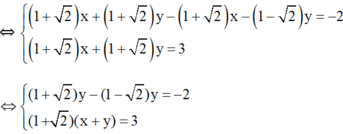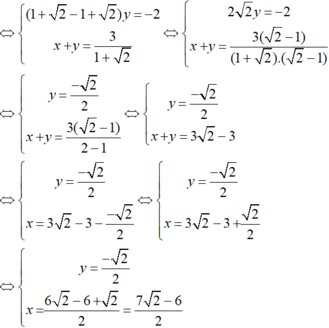Giải phương trình x^1+1/x^2+1/y^2+y^2
Hãy nhập câu hỏi của bạn vào đây, nếu là tài khoản VIP, bạn sẽ được ưu tiên trả lời.


\(\Leftrightarrow\frac{y+x}{xy}=\frac{1}{2}\)
=>\(\frac{x+y}{xy}-\frac{1}{2}=0\)
\(\Rightarrow\frac{-\left(x-2\right)y-2x}{2xy}=0\)
=>(x-2)y-2x=0
=>x-2=0( vì x-2=0 thì nhân y-2x ms =0 )
=>x=2
=>y-2=0
=>y=2
vậy x=y=2

ĐKXĐ: x<>2 và y>=-1
\(\left\{{}\begin{matrix}\dfrac{1}{x-2}-2\sqrt{y+1}=-4\\\dfrac{2}{x-2}+\sqrt{y+1}=7\end{matrix}\right.\)
=>\(\left\{{}\begin{matrix}\dfrac{2}{x-2}-4\sqrt{y+1}=-8\\\dfrac{2}{x-2}+\sqrt{y+1}=7\end{matrix}\right.\)
=>\(\left\{{}\begin{matrix}-5\sqrt{y+1}=-15\\\dfrac{2}{x-2}+\sqrt{y+1}=7\end{matrix}\right.\Leftrightarrow\left\{{}\begin{matrix}\sqrt{y+1}=3\\\dfrac{2}{x-2}=7-3=4\end{matrix}\right.\)
=>\(\left\{{}\begin{matrix}y+1=9\\x-2=\dfrac{1}{2}\end{matrix}\right.\Leftrightarrow\left\{{}\begin{matrix}y=8\\x=\dfrac{5}{2}\end{matrix}\right.\left(nhận\right)\)

a:
ĐKXĐ: \(x\notin\left\{\dfrac{3}{2};1\right\}\)
\(y=\dfrac{\left(x-2\right)^2}{\left(2x-3\right)\left(x-1\right)}=\dfrac{x^2-4x+4}{2x^2-2x-3x+3}\)
=>\(y=\dfrac{x^2-4x+4}{2x^2-5x+3}\)
=>\(y'=\dfrac{\left(x^2-4x+4\right)'\left(2x^2-5x+3\right)-\left(x^2-4x+4\right)\left(2x^2-5x+3\right)'}{\left(2x^2-5x+3\right)^2}\)
=>\(y'=\dfrac{\left(2x-4\right)\left(2x^2-5x+3\right)-\left(2x-5\right)\left(x^2-4x+4\right)}{\left(2x^2-5x+3\right)^2}\)
=>\(y'=\dfrac{4x^3-10x^2+6x-8x^2+20x-12-2x^3+8x^2-8x+5x^2-20x+20}{\left(2x^2-5x+3\right)^2}\)
=>\(y'=\dfrac{2x^3-5x^2-2x+8}{\left(2x^2-5x+3\right)^2}\)
b:
ĐKXĐ: x<>-3
\(y=\left(x+3\right)+\dfrac{4}{x+3}\)
=>\(y'=\left(x+3+\dfrac{4}{x+3}\right)'=1+\left(\dfrac{4}{x+3}\right)'\)
\(=1+\dfrac{4'\left(x+3\right)-4\left(x+3\right)'}{\left(x+3\right)^2}\)
=>\(y'=1+\dfrac{-4}{\left(x+3\right)^2}=\dfrac{\left(x+3\right)^2-4}{\left(x+3\right)^2}\)
y'=0
=>\(\left(x+3\right)^2-4=0\)
=>\(\left(x+3+2\right)\left(x+3-2\right)=0\)
=>(x+5)(x+1)=0
=>x=-5 hoặc x=-1
c:
ĐKXĐ: x<>-2
\(y=\dfrac{\left(5x-1\right)\left(x+1\right)}{x+2}\)
=>\(y=\dfrac{5x^2+5x-x-1}{x+2}=\dfrac{5x^2+4x-1}{x+2}\)
=>\(y'=\dfrac{\left(5x^2+4x-1\right)'\left(x+2\right)-\left(5x^2+4x-1\right)\left(x+2\right)'}{\left(x+2\right)^2}\)
=>\(y'=\dfrac{\left(5x+4\right)\left(x+2\right)-\left(5x^2+4x-1\right)}{\left(x+2\right)^2}\)
=>\(y'=\dfrac{5x^2+10x+4x+8-5x^2-4x+1}{\left(x+2\right)^2}\)
=>\(y'=\dfrac{10x+9}{\left(x+2\right)^2}\)
\(y'\left(-1\right)=\dfrac{10\cdot\left(-1\right)+9}{\left(-1+2\right)^2}=\dfrac{-1}{1}=-1\)
d:
ĐKXĐ: x<>2
\(y=x-2+\dfrac{9}{x-2}\)
=>\(y'=\left(x-2+\dfrac{9}{x-2}\right)'=1+\left(\dfrac{9}{x-2}\right)'\)
\(=1+\dfrac{9'\left(x-2\right)-9\left(x-2\right)'}{\left(x-2\right)^2}\)
=>\(y'=1+\dfrac{-9}{\left(x-2\right)^2}=\dfrac{\left(x-2\right)^2-9}{\left(x-2\right)^2}\)
y'=0
=>\(\dfrac{\left(x-2\right)^2-9}{\left(x-2\right)^2}=0\)
=>\(\left(x-2\right)^2-9=0\)
=>(x-2-3)(x-2+3)=0
=>(x-5)(x+1)=0
=>x=5 hoặc x=-1

1) \(-2x^2+x+1-2\sqrt[]{x^2+x+1}=0\)
\(\Leftrightarrow2\sqrt[]{x^2+x+1}=-2x^2+x+1\left(1\right)\)
Ta có :
\(2\sqrt[]{x^2+x+1}=2\sqrt[]{\left(x+\dfrac{1}{2}\right)^2+\dfrac{3}{4}}\ge\sqrt[]{3}\)
Dấu "=" xảy ra khi và chỉ khi \(x+\dfrac{1}{2}=0\Leftrightarrow x=-\dfrac{1}{2}\)
\(\left(1\right)\Leftrightarrow-2x^2+x+1=\sqrt[]{3}\)
\(\Leftrightarrow2x^2-x+\sqrt[]{3}-1=0\)
\(\Delta=1-8\left(\sqrt[]{3}-1\right)=9-8\sqrt[]{3}\)
\(pt\Leftrightarrow\left[{}\begin{matrix}x=\dfrac{1+\sqrt[]{9-8\sqrt[]{3}}}{4}\left(loại\right)\\x=\dfrac{1-\sqrt[]{9-8\sqrt[]{3}}}{4}\left(loại\right)\end{matrix}\right.\) \(\left(vì.x=-\dfrac{1}{2}\right)\)
Vậy phương trình cho vô nghiệm

1. \(2x^2-3x-5=0\)
\(\Leftrightarrow\left(2x-5\right)\left(x+1\right)=0\)
\(\Leftrightarrow\orbr{\begin{cases}2x-5=0\\x+1=0\end{cases}}\)
\(\Leftrightarrow\orbr{\begin{cases}x=2,5\\x=-1\end{cases}}\)
Vậy tập ngiệm của phương trình là \(S=\left\{2,5;-1\right\}\)
2x2-3x-5=0
2x2+2x-5x-5=0
2x(x+1)+5(x+1)=0
(x+1)(2x+5)=0
TH1 x+1=0 <=>x=-1
TH2 2x+5=0<=>2x=-5<=>x=-5/2
2. ta có:
2(x-2y)-(2x+y)=-1.2-8
2x-4y-2x-y=-2-8
-5y=-10
y=2
thay vào
x-2y=-1 ( với y=2)
<=> x-2.2=-1
x-4=-1
x=3


Ta có hệ : \(\hept{\begin{cases}x^2+y^2=\frac{1}{2}\\\left(x+y\right)^3+\left(x-y\right)^3=1\end{cases}}\) \(\Leftrightarrow\hept{\begin{cases}2x^2+2y^2=1\\2x^3+6xy^2=1\end{cases}\Leftrightarrow}\hept{\begin{cases}2y^2=1-2x^2\left(1\right)\\2x^3+6xy^2=1\left(2\right)\end{cases}}\)
Dễ thấy \(y=0\) không là nghiệm nên thế (1) và (2) ta có : \(2x^3+3.x.\left(1-2x^2\right)=1\)
\(\Leftrightarrow4x^3-3x+1=0\)
\(\Leftrightarrow\left(x+1\right)\left(2x-1\right)^2=0\)
\(\Leftrightarrow\orbr{\begin{cases}x=-1\\x=\frac{1}{2}\end{cases}}\)
+) Với \(x=-1\) thì ta có : \(\hept{\begin{cases}\left(-1\right)^2+y^2=\frac{1}{2}\\\left(-1+y\right)^3+\left(-1-y\right)^3=1\end{cases}}\) ( Vô nghiệm )
+) Với \(x=\frac{1}{2}\) thì ta có : \(\left(\frac{1}{2}\right)^2+y^2=\frac{1}{2}\Leftrightarrow y=\pm\frac{1}{2}\). Thỏa mãn hệ phương trình.
Vậy hệ pt có 2 nghiệm \(\left(x,y\right)=\left\{\left(\frac{1}{2};-\frac{1}{2}\right),\left(\frac{1}{2},\frac{1}{2}\right)\right\}\)

Lấy phương trình (2) trừ phương trình (1), vế trừ vế ta được:


Vậy hệ phương trình có nghiệm duy nhất 
Lưu ý:

Kiến thức áp dụng
Giải hệ phương trình bằng phương pháp cộng đại số
1) Nhân hai vế của phương trình với mỗi hệ số thích hợp (nếu cần) sao cho hệ số của một trong hai ẩn bằng nhau hoặc đối nhau.
2) Áp dụng quy tắc cộng đại số để được hệ phương trình mới, trong đó có một phương trình mà hệ số của một trong hai ẩn bằng 0 (tức là phương trình một ẩn).
3) Giải phương trình một ẩn vừa thu được rồi suy ra nghiệm của hệ đã cho và kết luận.
Minh moi lop 5 thui Hoàng Bảo Ngọc